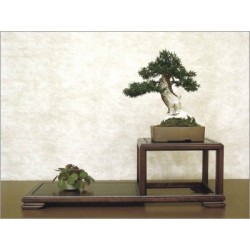Taxus Baccata is an evergreen tree of Europe, allied to the Pines, but having a peculiar berrylike fruit instead of a cone. These trees can live for many hundreds of years. Some old Yew trees are believed to be over 2000 years old. They can grow up to 15-25 feet tall in the wild.Many Yew trees have trunks formed by a coalescence of several stems, and they tend to become hollow when they grow old. Can be closely trimmed. If let go without trimming, it can become a very large bush. The wood of the Yew is light red in color, compact, fine-grained, and very elastic. The bark is very soft, branches or even the whole tree can be killed if the bark is removed. Plants produce very little fibrous root and should be planted in their final positions when still small.In early Spring the Yews can be seen in flower, and in late Summer the fruits appear. It is in leaf all year, in flower from March to April, and the seeds ripen from September to November. Fine-textured needles are 1/2 to 1 inch long, dark green on top and tinged yellowish beneath, usually arranged in two rows along the twigs, making a flat or V-shaped spray. The flowers are dioecious, individual flowers are either male or female, but only one sex is to be found on any one plant, and the red fruits are produced only by female plants. The red berry-like cones are very conspicuous and may persist on the branches well into Winter. The fruit is produced mainly on the undersides of one-year old branches. The fruits, with their bright arils, the fleshy covering over the seeds, look at first like small acorns, but they ripen into bright red berries. It is the seeds inside the fruit that is poisonous.






































Write your review
* Required fields
or Cancel